
Seoul Metropolitan Subway Line 1 of the Seoul Metropolitan Subway is a rapid transit and commuter rail line which links central Seoul, South Korea to Soyosan Station in the northeast, Incheon in the southwest, and Sinchang via Suwon and Cheonan in the south. The central underground portion of this rail line is the oldest subway section in the Seoul Metropolitan Subway system. Its branches and services cover a large part of the Seoul Capital Area; totaling 200 km (120 mi) in route length.
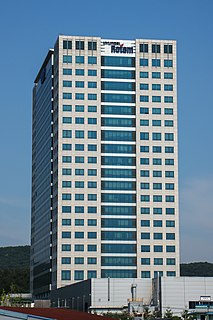
Hyundai Rotem is a South Korean company manufacturing rolling stock, defense products and plant equipment. It is part of the Hyundai Motor Group. Its name was changed to the current one from Rotem in December 2007 to reflect its parent company.

Seoul Metropolitan Subway Line 4 of the Seoul Metropolitan Subway is a long line crossing from the southwest to the northeast across the Seoul National Capital Area. The central section in Seoul City is operated by Seoul Metro with some trains offering through service to Korail's Ansan and Gwacheon Lines. The southern terminus (Oido) is in Jeongwang 4-dong, Siheung City, and the northern terminus (Jinjeop) is in Jinjeop-eup, Namyangju-si, Gyeonggi-do. In 2019, the Seoul Metro operated section had an annual ridership of 327 million or about 895,000 passengers per day.
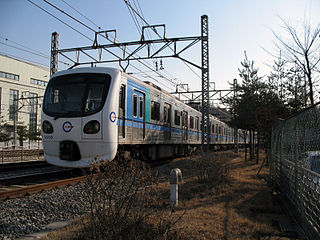
The Incheon Subway is a subway system serving the South Korean city of Incheon. The system is operated by Incheon Transit Corporation, and is part of the greater Seoul Metropolitan Subway.

Incheon Subway Line 1 is a 29.4-kilometer (18.3 mi) north-south subway line, part of the Incheon Subway system. The line is also included as a part of the overall Seoul Metropolitan Subway network; Bupyeong Station has a free transfer with Seoul Subway Line 1, Gyeyang Station connects with the AREX Line which leads to Incheon International Airport and Seoul Station, Bupyeong-gu Office Station has a free transfer with Seoul Subway Line 7, and Woninjae Station has a free transfer with the Suin Line.

Seoul Subway Line 9, operated by Seoul Metro Line9 Corporation, is a subway line in Seoul. The line runs east from Gaehwa Station or Gimpo Airport Station along the south bank of the Han River towards VHS Medical Center in Gangnam. In 2019, Line 9 has an annual ridership of 225 million or about 616,000 people per day.
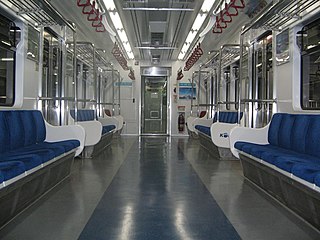
There are many types of trains in Seoul but they are usually similar to each other. Typically, train cars have four doors on each side. In between the doors are rows of either cushioned or non-cushioned seats for 7 people, except for the outer ends of each wagon where there are smaller rows of seats for 3 people, marked for the use by the elderly, disabled passengers, and pregnant women.

Incheon Subway Line 2 is a 27 station subway line 29.2-kilometer (18.1 mi) from Oryu-dong in Seo-gu to Incheon Grand Park., part of the Incheon Subway system. The line is also included as a part of the overall Seoul Metropolitan Subway network; Juan station has a free transfer with Seoul Subway Line 1, Geomam station connects with the AREX Line to Incheon International Airport and Seoul Station, and Seongnam also has a free transfer with Seoul Subway Line 7.

The Korail Class 1000 was a series of electric multiple units built in Seoul, South Korea for Seoul Subway Line 1. The cars were built in and entered service between 1974 and 1997. They were gradually retired from the late 1990s to 2020 by newer electric multiple unit trains.

The Korail Class 311000 trains, some train of which were formerly identified as Korail Class 5000 trains, are commuter electric multiple units in South Korea used on Seoul Subway Line 1. Class 311000 trains were manufactured and delivered between 1996 and 2006, and again from 2012 to 2014 to expand service on the Gyeongbu Line and the Gyeongwon Line, and to replace older trains.

The KTX-Sancheon is a South Korean high-speed train built by Hyundai Rotem in the second half of the 2000s and operated by Korail since March 2009. With a top speed of 305 km/h (190 mph), the KTX-Sancheon is the second commercial high-speed train operated in South Korea and the first domestic high-speed train that is designed and developed in South Korea.

The Intercity Train eXpress-Saemaeul abbreviated as ITX-Saemaeul (Korean: ITX-새마을) is a class of train operated by Korail, the national railroad of South Korea, it was introduced on May 12, 2014, to replace the Saemaeul-ho. The new ITX-Saemaeul trains have a faster average speed of 150 kilometers per hour. The name was taken from the Saemaul Undong after a public competition to determine the new train's name.

The Korail Class 341000 trains, formerly identified as Korail Class 2000 trains, are commuter electric multiple units in South Korea used on Seoul Subway Line 4. Class 341000 trains were manufactured and delivered between 1993 and 1999 to expand service on the Gwacheon Line and the Ansan Line sections of Line 4.

The Korail Class 351000 trains, formerly identified as Korail Class 2000 trains, are commuter electric multiple units in South Korea used on Suin-Bundang Line. Class 351000 trains were manufactured and delivered between 1993.
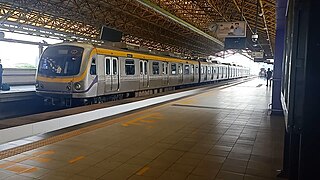
The LRTA 2000 class, also known by the Light Rail Transit Authority as the Rotem/Toshiba Megatren Model 2003, is a class of electric multiple units of the Light Rail Transit Authority (LRTA) in Metro Manila, Philippines, which began operation in 2003. It is used in Line 2.
Dawonsys is a South Korean company manufacturing rolling stock, display, semiconductor, plant equipment, and environmental systems. It changed its name to the current one in May 2001 to reflect its parent company.

The KTX-Eum or Korail Class 150000 is a South Korean high-speed electric multiple unit train manufactured by Hyundai Rotem and operated by Korail.The word 'eum' in Korean means 'uniting through connection'. This name is selected from the ideas of ordinary members, and it contains the desire to connect regions, people, and happiness through trains.
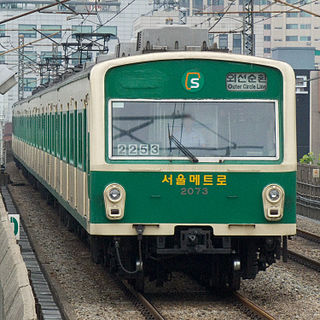
The first generation Seoul Metro 2000-series, also known as rheostat Seoul Metro 2000-series and chopper Seoul Metro 2000-series, are South Korean electrical multiple unit trains manufactured first by Nippon Sharyo, then Hyundai Precision & Industries, Daewoo Heavy Industries, and Hanjin Heavy Industries between 1983 and 1994 for Seoul Subway Line 2.

The Seoul Metro 1000 series Train was introduced and operated with the opening of Seoul Subway Line 1 in 1974. Currently, a total of 6 10-car trains are in operation.

The Seoul Metro 6000 series is a commuter train introduced by the Seoul Transportation Corporation from 1999 to 2000 with the opening of Seoul Subway Line 6. Currently, a total of 39 trains are in operation on Line 6 and 2 trains are in operation on Line 7.























